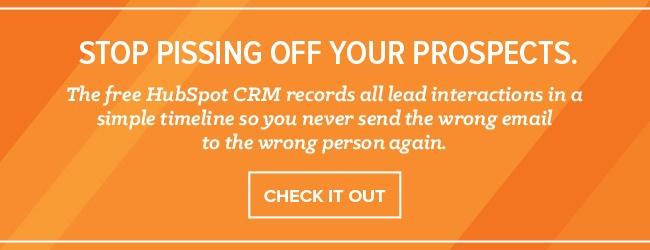I'm willing to bet you don’t often have sales calls where the buyer tells you exactly how to close the deal, especially if they're “impatient, difficult and demanding” like this one says he is.
You’re probably thinking, “Aren’t all prospects impatient, difficult and demanding?”
Sure … if that makes you feel better. But how many of them take the time to tell you how to close them? None, right?
Enter Corey Smith. In addition to being a two-time author, father of five, blogger, and speaker, he runs Tribute Media, a 15-person web design and marketing agency he started in 2007. Like most business owners, he buys things. Like most buyers these days, he's been sold to (unsuccessfully) by many salespeople. His frustration with "idiot" and "jerk" salespeople reached a boiling point recently, inspiring him to write the blog post, "Your Sales Pitch Sucks & 5 Tips to Solve It."
Below are the major takeaways from his very blunt feedback, along with some advice on how to sell to him (and buyers like him). While no single buyer should shape the way you sell to everyone, I think his insights are fairly typical of a small business owner and even most buyers. Even if not, his advice is grounded by experience from someone who knows the challenges of a salesperson firsthand. As the head of a 15-person marketing agency in the metropolis of Meridian, Idaho, I’m guessing Smith sells as much as he buys.
Without further ado, here are the six lessons Smith has for salespeople:
1) Don't be a jerk or an idiot when prospecting.
Most of you probably read that headline and relievedly thought, "I don't need to read this section. I'm not a jerk. I'm certainly not an idiot."
While it's true that you're highly unlikely to be an idiot if you're reading the HubSpot Sales Blog :) , chances are Smith thinks you are a jerk. Smith's team screens the majority of salespeople for him. He relies on his team to filter out "jerks" and "idiots," only passing along "pleasantly persistent" salespeople who customize their outreach.
When calling on a company, treat everyone with respect. A lower-level employee may be a bigger influencer than you think. Just because someone isn't a decision maker, doesn’t mean you should dismiss them or their authority -- unless you want to get disqualified. Whoever you reach out to or whoever responds, make sure you’re doing your homework on the person and personalizing your approach.
2) Show a genuine interest in your prospect's world.
"As the owner of a business you can bet that salespeople call on me all the time," Smith writes. "I get emails, snail mail sales letters, and phone calls on a daily basis. I am surprised how often I still get salespeople that pop in with the old, ‘Well, I happened to be in the neighborhood’ line."
While the pop-in approach is very lazy (not to mention outdated in most industries), it's not as if the vast majority of salespeople try much harder. Many salespeople never get a response from Smith because they are too obvious in their outreach. Their prospecting approach amounts to "I have something to sell and I want to see if you want to buy," he explains.
Questions and statements like the following real examples from Smith's inbox are dead giveaways:
- Are you adding new capabilities to your website design-development, Mobile Application & SEO department at any time soon or in the future?
- I noticed that you are interested in content marketing strategies and thought that my content marketing software might be a good fit.
These lines are examples of “check the box” research, where a salesperson notices a company has an interest in X area and then sends uncustomized template email about it. You could also call it “binary” research: Company is in Y industry, therefore send note that references Y industry.
Instead, Smith recommends finding something unique about each prospect and personalizing messages with that.
"For any salesperson that is good, I'm an open book," he writes. "I blog a lot. I'm very active on social media. If you simply take a little time to actually do your research, you’ll know exactly what I’m interested in."
Of course, not every prospect blogs frequently. But most companies do, providing an easy way to learn about internal initiatives, not to mention an easy way to genuinely connect with at least one employee. Customize your approach. Here’s a perfect example of leveraging a template, but customizing it to the recipient.
3) Bridge the understanding gap between your offering and your prospect's needs.
"If you get the first appointment, you have to ask questions about me that helps me know you are relevant, have done your homework, and are genuinely interested in me," Smith writes.
The value a product or service provides isn't always immediately obvious to a prospect, or relevant to their current priorities. Salespeople need to make those connections by asking their prospect questions about their current plans, challenges, and goals.
Smith warns salespeople not to rush this process.
"It's easy for me to identify when someone is being fake," he writes. "I can tell by the questions they ask and how quickly they get to the pitch."
4) Answer a prospect's questions when they ask.
Smith is tired of salespeople who won't provide pricing ranges when he asks for one.
"I don't want to hear, 'Well, I can't really give you a range because it really depends on X,'" he writes. "I'm smarter than that. You have worked with companies my size before. You have done other deals. You can give me a range. Very few products and services are so custom that you can’t put some sort of range on it.”
Many salespeople try to delay pricing conversations until they fully understand the prospect's needs, agree upon the potential ROI, or even until they get verbal buy-in to move forward. A recent study from HubSpot Research also shows that buyers often want to talk price and product on the first call. Here are some tips on how to handle pricing and product conversations early in a sales process.
5) Don't expect prospects to move the process along.
Even though (and maybe because) Smith knows how to sell he expects salespeople to manage the sales process.
"I don't want you to jump ahead to the 'buy my product' line," he writes. "But I am going to expect you to take me to the next step in the process. I'm going to expect trial closes. I'm going to expect you to ask for the next appointment. I'm going to expect follow-ups."
6) Don't be afraid to admit you could use some help.
Smith's final lesson is mentioned almost in passing in his conclusion: He likes helping reps who are trying to do a good job.
"When I meet a salesperson that is really trying to be successful and trying to do it right, I want that person to succeed," Smith writes. "If I see that you are genuine but are struggling, I'll help you through it. I'll even give you pointers and advice. The better you take that advice, the more likely we'll have a long-term relationship. A long-term relationship means I will give you more money and I will connect you with people that can give you more money.”
At HubSpot, we say that selling is about helping buyers buy. The flip side of that is sometimes true too. Smith probably isn't the only buyer who likes to help salespeople sell.
As salespeople, none of us are perfect. We all make mistakes. But if you're trying to get better and trying to do the right thing, buyers will recognize that. Don't be afraid to ask buyers for help, or at least find out if they found your conversations helpful. Most will give you feedback when you ask for it. As Smith suggests, this type of vulnerability can lead to closed business and referrals.
Do you make any of these mistakes? What are your strategies for improvement? Let us know in the comments below.












